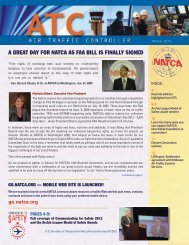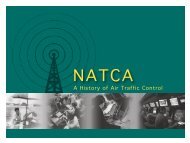Against the Wind - National Air Traffic Controllers Association
Against the Wind - National Air Traffic Controllers Association
Against the Wind - National Air Traffic Controllers Association
You also want an ePaper? Increase the reach of your titles
YUMPU automatically turns print PDFs into web optimized ePapers that Google loves.
224<br />
<strong>Against</strong> <strong>the</strong> <strong>Wind</strong><br />
FYI<br />
Until 1998, <strong>the</strong> FAA<br />
ranked its towers and TRA-<br />
CONs on a five-tier scale<br />
according to traffic volume.<br />
Level V was reserved for<br />
<strong>the</strong> busiest facilities. En<br />
route centers were ranked<br />
on a different three-level<br />
scale, and controllers at <strong>the</strong><br />
busiest facilities were paid<br />
<strong>the</strong> same as those at Level V<br />
towers and TRACONs.<br />
Level I VFR (Visual<br />
Flight Rules) towers were<br />
not equipped with radar<br />
and handled general aviation<br />
traffic in good wea<strong>the</strong>r only.<br />
Under <strong>the</strong> reclassification<br />
plan adopted by <strong>the</strong><br />
FAA in 1998, all facilities are<br />
now ranked from ATC-4 to<br />
ATC-12 based on traffic volume<br />
and operational complexity.<br />
Two higher grades—<br />
ATC-13 and -14—were built<br />
into <strong>the</strong> scale to accommodate<br />
future growth.<br />
2001<br />
agreement with <strong>the</strong> FAA<br />
to implement <strong>the</strong> Direct<br />
Placement Program.<br />
“It was a victory for<br />
<strong>the</strong> people. It was a loss for<br />
<strong>the</strong> union,” says Krasner,<br />
who regards <strong>the</strong> issue as<br />
<strong>the</strong> one key failure of his<br />
presidency.<br />
A twelve-member<br />
Level I Contracting Committee,<br />
composed equally<br />
of FAA managers and<br />
union representatives, was<br />
formed to carry out <strong>the</strong><br />
program. The agency gave<br />
NATCA some latitude by<br />
allowing it to recommend<br />
which facilities would be<br />
transferred to private operators<br />
each year.<br />
Although <strong>the</strong> program was hailed as a success<br />
for <strong>the</strong> controllers involved, <strong>the</strong> overall toll on<br />
<strong>the</strong> union is represented by what its members call<br />
<strong>the</strong> “Wall of Shame.” Covering one side of <strong>the</strong> main<br />
conference room on <strong>the</strong> fifth floor of NATCA headquarters<br />
are <strong>the</strong> local charters of 101 towers that were<br />
once unionized but have since been contracted out.<br />
Ano<strong>the</strong>r thirty-four privately run towers have been<br />
Jan. Jan.<br />
The FLRA certifies NATCA as <strong>the</strong> exclusive bargaining representative<br />
for <strong>the</strong> FAA’s 50 regional and center counsel.<br />
4<br />
20<br />
Japphire<br />
Wall of Shame: Union charters from towers that have been contracted out to private firms hang in a<br />
conference room at NATCA headquarters. The union has reorganized thirty-four contract towers.<br />
reorganized by NATCA. Unless it’s absolutely necessary,<br />
Krasner won’t enter <strong>the</strong> room.<br />
“I just can’t look at it,” he says. “It eats me<br />
alive.”<br />
One of Krasner’s fears about <strong>the</strong> Direct Placement<br />
Program reared its head not long after <strong>the</strong><br />
remaining towers went private, posing a significant<br />
challenge to NATCA’s future. In 1998, Congress directed<br />
<strong>the</strong> FAA to study <strong>the</strong> feasibility of expanding<br />
Transportation Secretary Rodney E. Slater leaves office after<br />
serving since February 14, 1997.




